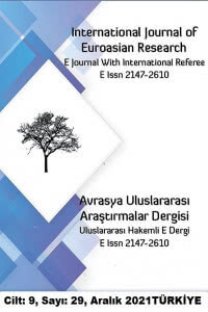RUANDA'YI HATIRLAMAK: JEAN PHILIPPE STASSEN'İN DÉOGRATIAS İSİMLİ GRAFİK ROMANINDA TARİH, BELLEK VE SOYKIRIM
XX. yüzyılda, çok sayıda toplu katliam yaşanmıştır. Toplumsal ayrışmanın kaçınılmaz sonucu olarak yaşanan bu katliamlarda milyonlarca insan ölmüş, yaşanan dramların bireyler üzerindeki travmatik etkisi kuşaklar arası aktarımla toplumsal belleğe kazınmıştır. Bu geniş ölçekli şiddet eylemlerinden biri de hiç şüphesiz Ruanda soykırımıdır. Sömürgeci ve yerel güçlerin etkisiyle tırmanan toplumsal kamplaşma bir iç savaşa evrilmiş, sonuç olarak Ruanda'nın halklarından olan Hutuların diğer Ruandalılar Tutsileri ve Twaları hedef alan kanlı şiddet eylemleri gerçekleştirmişlerdir. Bu şiddet eylemleri sonucunda yaklaşık yüz gün içinde 800.000 kişi hayatını kaybetmiştir. 1994 yılında yaşanan bu vahşet, sosyolojik, antropolojik, politik ve edebi birçok çalışmanın konusu olmuştur. Ruanda soykırımını bireysel ve toplumsal travma ve bellek ekseninde ele alması bakımından Belçikalı çizer Jean-Philippe Stassen'in Déogratias(2000) adlı eseri de önemlidir. Eserde soykırım süreci, tanık olduğu insanlık dışı olayların ardından ölümcül bir deliliğe tutulan genç Hutu Déogratias'ın gözünden anlatılır. Zamansal düzlem olarak soykırımın hemen sonrasında başlayan bu anlatıda zihinsel geri dönüşlere sıklıkla yer verilir. Gerçek tanıklıkların derlenmesiyle kaleme alınan bu kurgusal eserde, çizer Stassen söylenmesi mümkün olmayan, resmi tarih anlatılarında yer almayanları bir “bellek ödevi” bilinciyle aktarır. “Soykırımı ve sonuçlarını içeriden görmek” fikrinden yola çıkan Stassen'in karşılaştığı sorunsal şudur: kelimelere dökülmesi imkânsız olan bu insanlık dramını çizgi ve resimlerle nasıl anlatmak gerekir? Bu çalışmada Stassen'in grafik romanı Déogratias tarih ve belleğin çizgisel temsilleri ekseninde ele alınacaktır.
REMEMBERING RWANDA: HISTORY, MEMORY AND GENOCIDE IN JEAN PHILIPPE STASSEN’S WORK DÉOGRATIAS
In the XXth century, there had been a large number of slaughters and massacres. During those massacres that took place as inevitable result of social dissociation and marginalization, millions of people were dead and the traumatic effects of these tragedies are carved into social memory via their intergenerational transmission of memories. One of these acts of violence is without doubt Rwanda genocide. Growing social polarization caused by colonial and local powers had evolved into a violent civil war and as a result, Hutu, one of the Rwandan people, had begun to perform act of violence targeting other Rwandan people, Tutsiand Twa. Because of these acts of violence, 800.000 people lost their live just in one hundred days. That atrocious genocide in 1994 became the main subject of many sociological, anthropological, political and literary researches. Belgian comics creator Jean Philippe Stassen’s work Déogratias (2000) is considered one of those important works as it treats the genocide on a social and individual base. The process of genocide is narrated from the point of view of young Hutu Déogratias, the protagonist of the story who became severely insane after having witnessed inhuman, diabolical events. In this fictional work that begins right after the genocide, there are many flashbacks. Based on real testimonies, Stassen tries to tell the untold, truths that aren’t mentioned in official History narratives considering the “memory duty”. Based on the idea that “seeing the genocide and its results from the inside” Stassen encounters following problem: how to depict this humanitarian plight which is impossible to put in words with drawings and pictures? In this article, Stassen’s work Déogratias will be examined in terms of linear representations of history and memory.
___
- BARNETT, Michael(2002),Eyewitness to a Genocide : the United Nations and Rwanda, New York:Ithaca ve Cornell University Press.
- CHRÉTIEN, Jean-Pierre ve Gasanabo, Jean-Damascène, (2007)“Le génocide des Tutsi du Rwanda”, Comprendre les génocides du XXe siècle, (Ed. B. Lefebvre ve S. Ferhadjian, Paris: Bréal, s. 130.
- DELISLE, Philippe, (2008),Bande dessinée franco-belge et imaginaire colonial des années 1930 aux années 1980, Paris: Karthala.
- KUPERMAN, Alan J (2000),Rwanda in retrospect. Foreign Affairs,1, 94-118.
- MARIE, Vincent, (2011),La fabrique d’un imaginaire du génocide tutsi dans la bande dessinée Déogratias de Stassen, Témoigner entre histoire et mémoire, Sayı 109, 194-208.
- MOMBERG, Marthie,(2016), Hotel Rwanda : individual heroism or interconnectedness in the portrayal of Paul Rusesabagina?, Scriptura, Sayı: 115(1): 1-12.
- NYATAYA, Isaboke Peter Kennedy ve JOHN, Gacinya, (2017), Human Trafficking Incidence in Rwanda: Its Challenges, Prevention and Control, International Journal of Research in Sociology and Anthropology Cilt 3, Sayı 1, 2017,19-29.
- STASSEN, Jean Philippe, (2000) Déogratias, Marcinelle: Dupuis.
- SULEIMAN, Susan Rubin (2006),Crises of Memory and the Second World War. ABD: Harvard University Press.
- https://www.courrierinternational.com/article/2004/04/08/dans-ces-pays-la-ungenocide-n-est-pas-trop-important
- https://la-plume-francophone.com/2009/02/15/stassen-deogratias/
